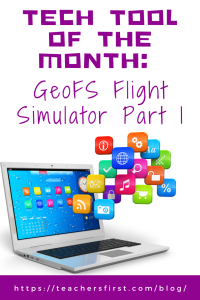GeoFS is a free online flight simulator with an open-source platform to render the global landscapes you can fly over. The free tool will work on any device with a web browser (including Chromebooks). Control the aircraft (or hot air balloon) using a mouse, joystick, or keyboard control buttons. Users can choose the destination of where the virtual flight will take place, as well as the type of aircraft. There are 30 types of aircraft to choose from, and students can play this simultaneously as multiplayer. There is a chat feature available that must be enabled for students to access. (We suggest keeping this feature turned off.) No installation is required, and instructions are provided on the site. This tool would work on an interactive whiteboard as a whole class experience or, better yet, on individual devices. This activity could be done in the classroom or as part of a blended, flipped, or remote learning lesson related to aviation.
Applying the Triple E Framework
The Triple E Framework, created by Dr. Liz Kolb, believes that “effective technology integration begins with good instructional strategies and not fancy tools” (tripleeframework.com). Dr. Kolb wrote a book on the topic, Learning First, Technology Second (ISTE, 2017), that lays out the three main uses for technology in education: to Engage, Enhance, or Extend learning goals. We can use this framework to decipher why we use specific classroom tools. Here is a rubric based on the Triple E Framework you can use to evaluate whether GeoFS (or any other technology) is a good fit with your learning goals and whether you should use it in your lesson.
- Engage in learning goals: The students are motivated to begin learning as GeoFS allows students to try the simulator themselves and figure out how to manipulate the controls. In addition, students are active learners using GeoFs, as they actively move the controls and do not passively watch.
- Enhance learning goals: GeoFS aids students in developing a more sophisticated understanding of the content (including aviation or geography) because they are manipulating the tool. This tool also creates paths for students to demonstrate their knowledge of the learning goals in a way they cannot do without technology. For example, students can use the simulator to deepen their understanding of aviation and geography.
- Extend learning goals: Dr. Kolb describes extended learning as an opportunity for students to learn, connect, and collaborate outside the regular school day and bridge the school day and real-life experiences. GeoFS could be completed as a remote, flipped, or blended learning activity. The site would also make an ideal asynchronous learning experience.
SAMR Connection
The SAMR Model, by Dr. Ruben Puentedura, suggests that technology implementation has four levels. Therefore, we can use this model as a guideline to analyze how we use technology tools in the classroom. For example, using GeoFS would be at the Redefinition levels.
- Redefinition: At the highest level of SAMR, the technology allows the creation of previously inconceivable new tasks. With GeoFS, students can simulate flights and visit many locations virtually from around the world. None of this would be possible without technology.
Don’t miss Part 2 of the Tech Tool of the Month: GeoFS, where we’ll discuss using the tool and classroom ideas. In the meantime, let us know how you have used GeoFS in your education setting in the comments below.


